It was after leaving the safe confines of Vault 18, and heading west on an extended trek across an almost entirely deserted road towards Union City, that the initially phenomenally designed and written Fallout: New California started to show cracks in the plaster. It was subtle at first, but as I reached the I-138 – I-15 Beltway, and came across a massive battle between the NCR and Survivalist Raiders that quite literally exploded a long stretch of highway with mortars and vertibirds, questions starting poking at the back of my brain. The biggest one being: What kind of game is Fallout: New California trying to be?
Keep in mind, everything within this review is based around one 18ish hour playthrough, with one story path. New California has branches upon branches of narratives all weaving parallel and often intersecting with one another, similar to how New Vegas was structured. But where New Vegas started weaving and everything together around ten hours into the narrative proper, New California does it from the very first frame all the way to the end. So it’s entirely possible I accidentally played New California in a way that had me miss out on a ton of content.
For those of who may not know, Fallout: New California is a massive, character-focused narrative mod for Fallout: New Vegas. It’s been in development for seven years, by Radian-Helix Media, lead by Branden Lee and Rick Hukkanen. It takes place in 2260; twenty years after NCR-Enclave War and twenty years before the events of Fallout 3 and New Vegas. The game’s world space is about 66% the size of New Vegas, and it has nearly 17,000 lines of professional-level dialog from 60 voice actors.
You play as an orphan adopted into Vault 18, a control vault in the San Bernardino Valley, otherwise known as The Pass, and the narrative puts you up against, or allies you with, the last remnants of the Enclave on the west coast, a massive coalition of raiders called the Survivalists, the New California Republic (NCR) , and the Gangs of New Reno. It has thirteen different endings, many of them radically different from one another, and serves as an unofficial prequel to both Fallout 3 and New Vegas. But mostly New Vegas.
New California, in a word, is a beast. An occasionally unwieldy, slightly unbalanced beast, but a powerful beast all the same. A beast that you can download from here and here.
Anyway, up until the Beltway, I had gathered a small army of companions composed of my player character, her giant robot, her robo-dog, the mostly-functioning couple of Eric and Jamie, a recently-slightly-less-amnesiac badass tribal Kurtz, the “popular girl” Jennifer Hail, and the “unpopular girl” Kira Mann. Due to the fact that I had chosen the “Path of the Scientist” — one of two primary narratives that begins with a single choice you make about four seconds into the game — I didn’t really have a good handle on who Eric, Jamie or Jen were. From playing the Alpha version of New California, back when it was still called Project Brazil, I knew that the “Path of the Warrior” did indeed take time out to develop those characters…but also left the option open to interact with Kira and Kurtz anyway.
After following along with the development of New California, and remembering that its design and writing philosophy was heavily inspired by Fallout: New Vegas and Fallout 2, I assumed that my companions would have quite a lot to say as the story moved forward, and most of what I missed back in the prologue would catch up to me. Unfortunately, I was wrong.
From quest to quest, running across the sparsely populated and confusingly large wasteland of The Pass, the only two characters who ever had anything to say were Kira and Kurtz. And even then, it wasn’t a lot. Kira would mention her primary motivation, finding her family, but the well characterized young woman who I got to hang around with in Vault 18 seemed to all but vanish once we’d reached the formal end of the first chapter. Kurtz had more to say as we moved through the game, but all of it seemed to be carefully scripted as to not affect the player character’s interactions with the world. There were also some mentions of both Kira and Kurtz going to talk to NPCs at what sounded like critical moments that just never happened.
It’s possible this was a bug that existed in pre-release build of the mod that I played, but I’m not entirely sure it was. What few moments of situational dialog I could find seemed to relate to events that simply didn’t happen in my playthrough, which makes me think that I did something that messed with quest. Having a few triggers missing makes sense, but nearly all of them? To make sure I would get the full intended experience, I only used the mods that the development team recommended with a fresh installation of New Vegas. To my knowledge, everything else in the game appeared to work as intended.
It’s easy to guess as to why Kira and Kurtz got more attention and more opportunities to speak their minds than the rest of your makeshift family from Vault 18: they’re the only two you can’t miss. I’m fairly certain it’s possible that Kira doesn’t join your team, though you kind of have to try to make that happen, but Kurtz will always be around if you want him there.
What baffles me the most, though, is that right before the end of the first chapter, after you escape the Vault, there’s a mechanic that’s introduced where you need to keep your new family and team together by being a good leader. You need to make sure that they aren’t at each other’s throats, and that their feelings are kept in check for the sake of survival. You can interrupt five (six, if you took Path of the Warrior and played your cards right) people arguing by firing your gun into the air, and then give a speech depending on your SPECIAL, skills and perks.
This kind of mechanic, and the way it was introduced, would make a player naturally assume that it would show up periodically at important branching points in the game’s narrative. It’s an idea that I loved, and was excited to see how it would play out in the future. Except, I literally never saw it happen again. There was so much potential with that, and the interpersonal relationships that were established, and to see it all just…ignored after leaving the Vault confuses me.
There are two more instances of “give a big speech” to a crowd of people within the game’s multi-branching narrative that I’m aware of, but neither of them have anything to do with keeping your core group together.
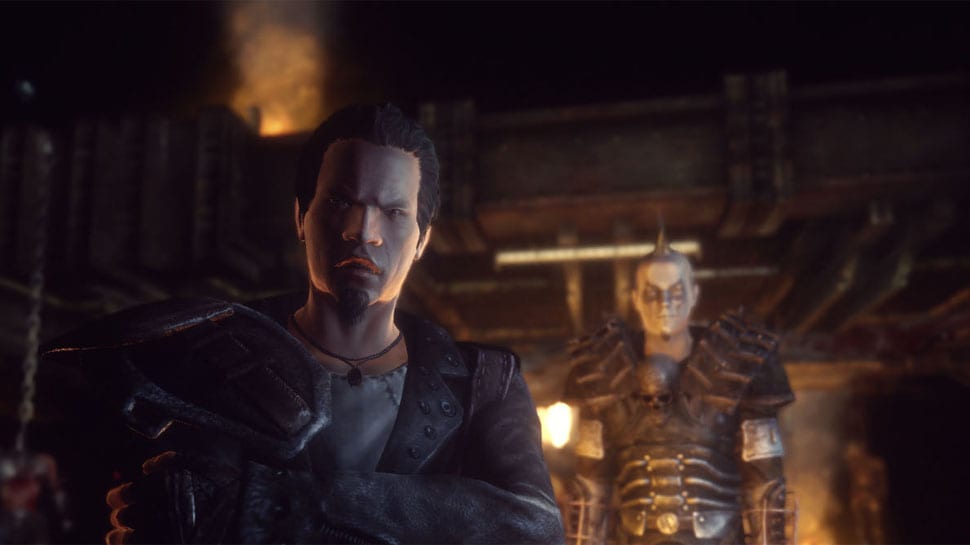
All of that being said, pretty much every other character you meet in New California is memorable and developed to an at times ludicrous degree. Every time I met someone new, I couldn’t help but wonder why my companions weren’t nearly as interesting as them. This is something New Vegas managed to avoid by having a lot of topics already be available for conversation once you recruited any companion. More would open up as their personal storylines unfolded, and as such you’d learn more about them.
As I moved further into the game, and actually got to Union City, things started to pick up a little bit. New California’s depiction of the NCR’s rampant corruption and “manifest destiny” approach to expansion is very much in line with New Vegas and Fallout 2. The depth that it goes into exploring this on a localized scale is just as intelligent and well executed as any example from those two games. The interplay between General Silverman and Senator DuVille is extremely entertaining and feels right at home within the universe.
But then I walked outside and an Raider-controlled vertibird bombed main street. It was more than a little jarring. At this point, I was starting to notice an odd trend with how New California tells its story. Every time I’d get some meaningful, deep and interesting character interaction and get to make some important, genuinely morally complex choices, I’d walk around a corner and a giant set piece would happen. In the prologue, the Vault exploded. At the Beltway, the road exploded. Union City? Another road exploded. This continues to happen throughout the game, almost as if there was some sort of quota. It was genuinely strange.
Some examples are better than others, and there’s nothing wrong with the execution, but the pattern itself is what stuck out to me. For a game that prides itself so much on variety, player choice and a fully-realized world where nothing is ever black or white, why fall back on design choices that are, as someone with a decent understanding of Bethesda’s mod tools, inherently far more difficult to implement than pretty much anything else? A few instances did indeed show us more about the world of The Pass, but others weren’t as effective in that effort.
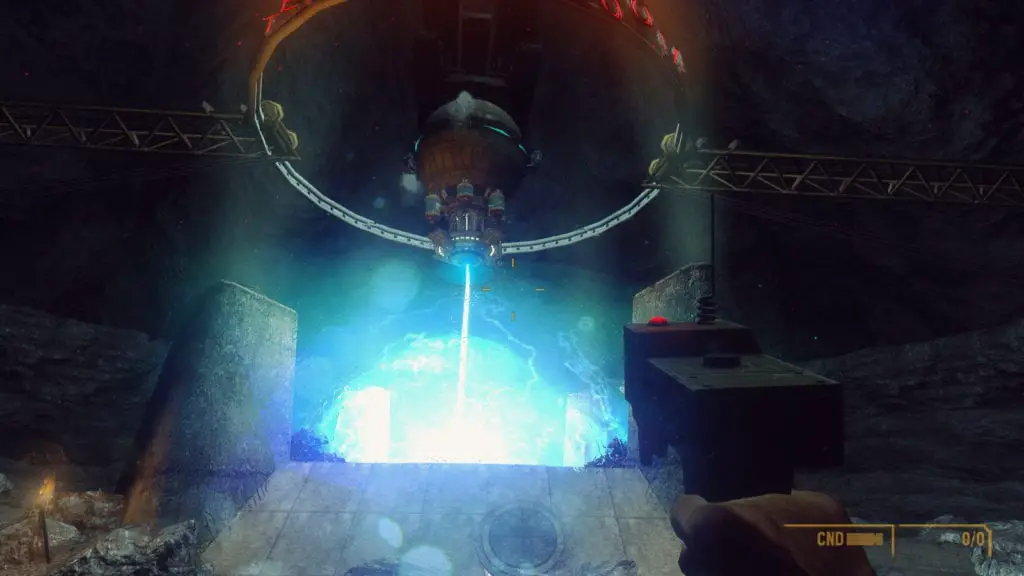
There are also instances within the narrative where the game basically tells you to run like hell, sometimes back the way you came, which, considering the at times annoying scale of the game world, is more frustrating than exciting.
All of that being said, New California, when it actually allows its story to flow and expand, does so organically and with exceptional tact. There are some instances where it feels like the game is overcompensating and writing way too much dialog to make sure it has enough, but none of it is ever bad or poorly delivered. The voice cast is pretty stellar and consistent throughout, which is seriously impressive. There were a few audio glitches and odd levels here and there, but nothing I’m sure wouldn’t be patched out in the next week or so, if not sooner or possibly already. As an aside, I do want to commend New California for having a significant chunk of its NPCs actually speak Spanish. The game is set southern California, and yet, if memory serves, the first time we ever actually get a reminder of close Mexico is to the West Coast Fallout titles was in New Vegas with Raul.
New California’s primary narrative is, without spoiling anything, absolutely worthy of the Fallout title. The stories you hear from a certain bounty hunter are a particular highlight, and the expansions of lore you can dive into within Vault 18 (the premise itself of which is the perfect Fallout balance of particularly terrifying and clever) and other areas are a blast. It all fits together into a surprisingly tight package, and it’s unfortunate that all of it is sorta buried behind a game with a weird identity crisis.
To its credit, New California never exploits or shoulders too much of the burden of its setting on previous installments. That is to say, it never uses a reference to factions or historical events we, the player, already know about, with reverence. The characters and world of New California operates as if it was part of the official Fallout-canon with well deserved confidence. All of that stuff is just part of their reality. It’s their life…even if some of it has fallen into myth and legend.
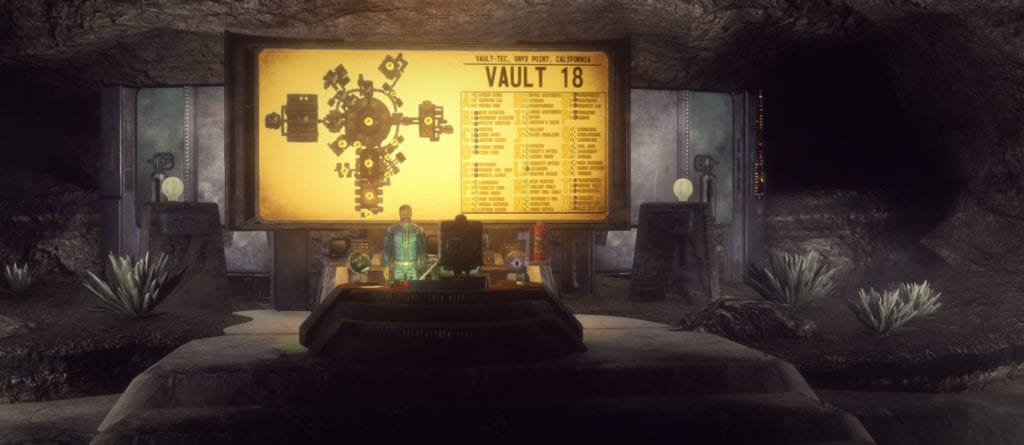
The way that New California tackles dialog and SPECIAL stats is probably my favorite thing about it. In New Vegas, there were skill checks and SPECIAL checks that opened up new dialog options that also allowed for different ways to accomplish a goal. There were also a few, not a lot, of Perk checks. New California expands on this system in a way that I absolutely love.
The perks you gain from conversations, and exploring the game’s larger world, have an actual impact on not only your stats, but also the story. A perk you get in hour one can be applied in hour ten, and just because you pass a skill check doesn’t necessarily mean you’ll succeed in what you set out to do. Sometimes the characters will get what you’re saying, but ultimately won’t care or change their mind. It lends another layer of immersion to the world that is endlessly intriguing to me.
SPECIAL stat checks, which typically only showed up once, and rarely twice in a conversation in New Vegas, now appear in at least 50% of conversations in the game. There are even situations where the further you get into a topic, the harder the checks become, which creates a very effective illusion of an actual conversation where two sides have clearly set personal boundaries about what they will and will not talk about. Y’know, like talking to people in your everyday life. It’s a small thing that has a big impact on the characters you meet, even if it’s only a brief encounter.
Aside from my problems with how companions are handled in New California, my biggest issue with the game is that so much of the world is barren desert. And not like how New Vegas was a desert; that actually had side quests and places to explore in between larger settlements to break up the monotony of going from A to B. New California doesn’t have anywhere near enough of those to justify the scale of its worldspace. The side quests you do find are actually pretty fun and tie into the larger lore of the narrative, but they’re few and far between.
The map also, notably, doesn’t feature many landmarks by which to orient yourself. It’s not something you’ve ever needed to actually do for gameplay reasons, but I always found it help with immersion and establishing the game world if you could look towards a giant tower (White Gold Tower in Oblivion, Washington Monument in Fallout 3, Lucky 38 in New Vegas, That Giant Mountain in Skyrim, and whatever-it-was-called in Fallout 4) to get a feel for where you physically were in relation to everything else.
Walking literally six minutes north from Union City to a power relay (which you can avoid doing under certain circumstances, at the cost of not further fleshing out the narrative) and running into one settlement with no quests and only one character who has anything interesting to say on the way is not enough from a gameplay perspective. Narratively, sure, yes, you can make an argument that this particular region of California should be that barren. But what makes sense there does not always translate well to gameplay.
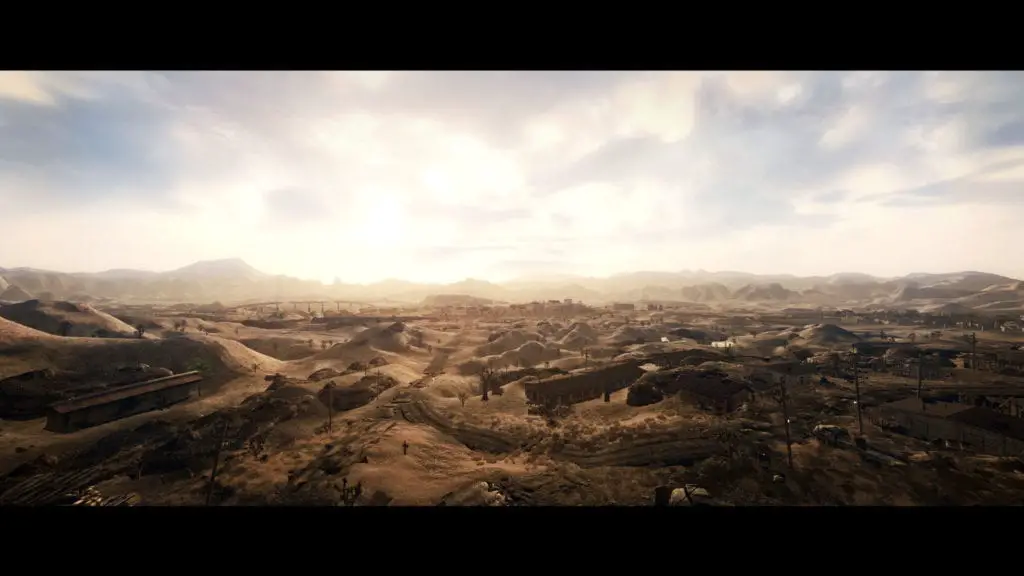
I’m sure that the two custom-voiced radio stations, both of which are filled with an impressive combination of exclusive covers, public domain tracks, and brand new music composed explicitly for the game as well as their respective DJs, is meant to serve as a sort of bridge or stop-gap between points of interest, just as it was for Fallout 3, New Vegas, and Fallout 4, but it’s just, again, not enough.
There was a point later in the game, the context of which I’m not going to spoil at the request of Project Lead Branden Lee, where you need to run all over The Pass…revealing map markers that have their discovery distance set to about four feet. Basically, this means that exploring The Pass is very much discouraged, since finding your footing in an open world game like this requires a decent amount of map markers so the game doesn’t feel so empty. These were places that I had actually passed through prior to this specific quest, and there weren’t any map markers.
New California leaned way too much into the authenticity of the wasteland than it needed to. I’m sure the goal was to increase immersion, but all it ultimately did was take me out of the experience. Half the time I wouldn’t even get a combat encounter when walking about thirty percent across the game’s map. Not everything needs to be combat, but if developing more side quests just wasn’t realistic, then the least that could be done would be to slap down a few more raider camps in the general pathways players would take to get from A to B. That honestly makes more narrative sense than there being empty tracts of land, considering the difficulty the NCR is having with the allied Raider factions all across San Bernardino.
This disconnect was so distinct that there were times where it felt like the first fifth of the story, which took place almost entirely in the superbly designed and fleshed out Vault 18, was an entirely different game from everything that happens later in The Pass. Part of that might be because I played the Alpha way back when, which was pretty much only that part of the story, but even that had undergone some significant overhauls and redesigns in the past five years. It really didn’t play the same, even if some aspects remained familiar.
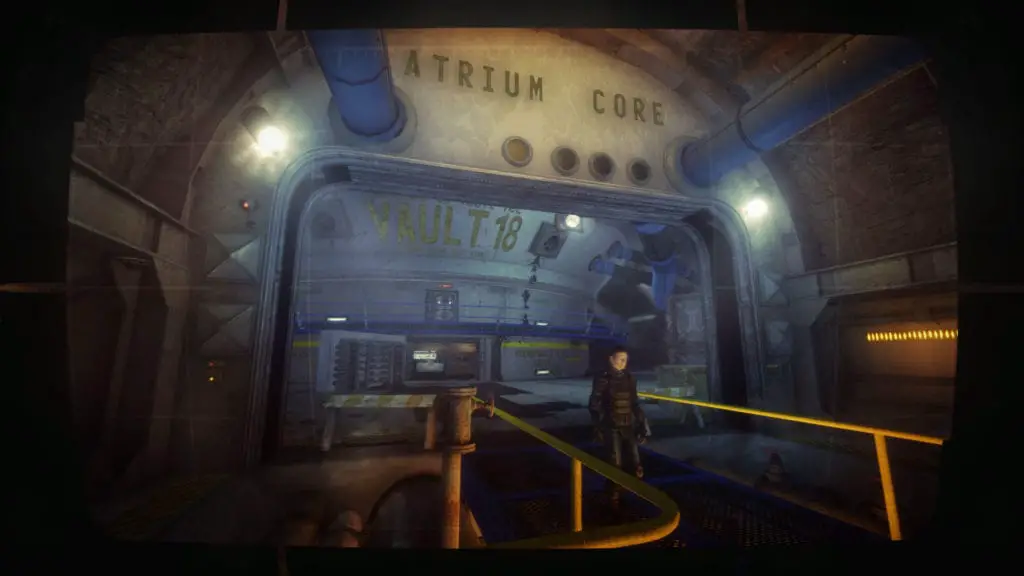
Vault 18 felt like a place where people actually lived, worked, and eventually died. It had a layout that made sense, and pretty much every NPC in there had something interesting to say and worth listening to. The Pass mostly doesn’t feel like that. There are moments scattered about, and when you find them they’re effective and draw you in like nobody’s business, but when they end you’re right back in the middle of the nowhere.
Fallout: New California is an uneven game with phenomenal character writing, attention to detail, inspired new mechanics and expansive world building that would be a worthy addition to the Fallout canon. At its best, New California stands shoulder-to-shoulder with the likes of Fallout 2 and New Vegas. At its worst, it’s a giant empty desert that constantly reminds you of how close it came to accomplishing what it set out to do.
It’s 100% worth playing, but don’t go in expecting to get your full singleplayer Fallout fix. New California probably won’t sate you. At least, not on just one playthrough. The sheer number of choices and endings packed into New California all but guarantees that each replay of the game will be fresh and interesting…even if getting from one point to the next can be a bit of a slog.
Trust me: it’s way more fun the second time around.

